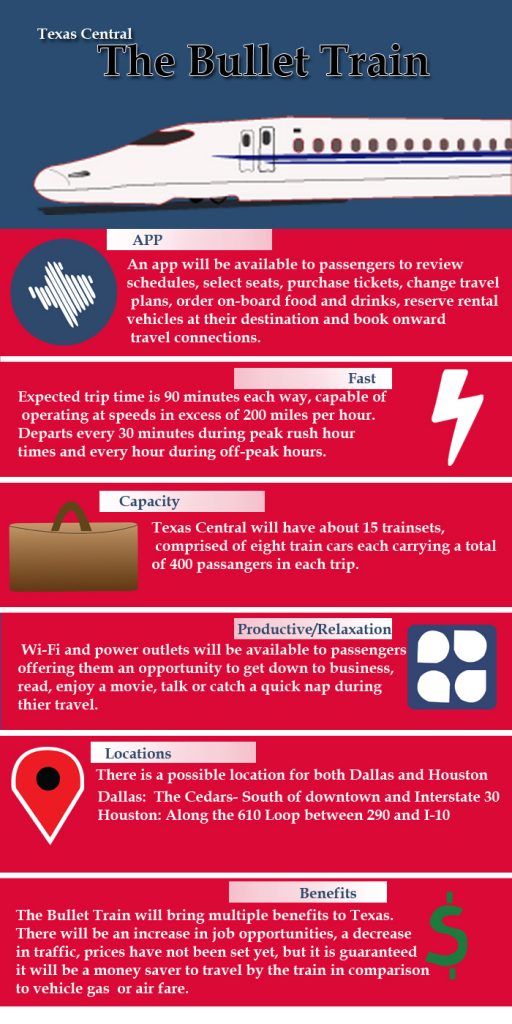
Houston/Dallas on track for high-speed rail project

A high-speed train, also known as a bullet train, has been a popular and controversial topic in urban areas where traffic congestion is increasing. Because of the rapid growth in the cities of Houston and Dallas, and the high demand for travel between the two cities, a Houston/Dallas connection was chosen as the best place for a high-speed rail project among 97 cities studied across the nation.
Texas Central Partners, LLC, a private company, is bringing this project to Texas. The goal of the project is to connect two metropolitan cities using sophisticated technology that will allow people to travel between Houston and Dallas in approximately 90 minutes.
Texas Central Partners is working closely with Central Japan Railway Company (CJRC), a corporation that operates more than 300 high-speed trains in Japan. CJRC has been using leading-edge technologies for more than 50 years with no fatalities or accident-related injuries and will provide its technical support to the design, construction and operation of this project.
“Texas Central will have about 15 train sets, comprised of eight train cars each, that leave the stations every 30 minutes during peak rush hour times in the mornings and afternoons, and every hour off-peak hours,” said Kate Heckenkemper, media relations specialist at Texas Central Partners. “Six hours [will be] reserved each night for maintenance and upkeep.”
The 240-mile rail line will hold approximately 400 passengers and will operate at a speed of 205 miles per hour.
Passenger stations will have connection options, and there will be retail stores and restaurants inside each station. Passengers will also be able to use an app to buy tickets, review schedules, order food onboard and reserve rental vehicles.

Houston Mayor Sylvester Turner said he is excited about this project.
“People recognized that we needed something transformative, something that would be different, something that would meet the needs of both regions and, quite frankly, meet the transformative needs for the state as a whole,” Turner said in a video posted on the mayor’s website. “This is a huge opportunity to improve Texas economy, enhance mobility and create Transit Oriented Developments (TOD).”
Dallas Mayor Mike Rawlings also expressed his enthusiasm and support for the project at a press conference held at Houston City Hall in March 2014.
“This is a brilliant idea, and we are enthusiastic about this,” Rawlings said. “There is a lot of consumers’ benefit…if we do this right, there will be tens of thousands of people that will be employed by this over the long term.”
Construction of a track between the cities of Houston and Dallas will cost an estimated $10 billion in private investment. Texas Central Partners will rely on private companies and federal loan programs to finance this project.
Members of this project are also in dialogue with the Department of Homeland Security and the Transportation Security Administration (TSA) elaborating comprehensive security plan procedures that are both visible and unseen by the public to protect the safety of passengers and employees.
Despite the expected positive impact on the state’s economy and the support of different organizations for this project, there are certain procedures that still need to be followed before this project is implemented.
The Federal Railroad Administration (FRA) along with the Texas Department of Transportation is currently preparing an Environmental Impact Statement (EIS) analyzing the potential routes that will have the least impact on local communities using social as well as environmental constraints required by the National Environmental Policy Act (NEPA).
“The release date for the Draft Environmental Impact Statement (DEIS) has been pushed back due to the need for additional agency coordination,” said Desiree French, FRA public affairs specialist. “We anticipate the DEIS will be released by the end of spring 2017.”
The FRA released a Corridor Alternatives Analysis Technical Report analyzing the potential routes conducting a pass/fail test based on physical characteristics, operational feasibility and environmental constraints giving all of these routes equal weight in its determination.
Based on the evaluation of this report, the FRA determined that the route referred to as the Utility Corridor, because of the existent high voltage electrical transmission lines, passes all the screening criteria. The Utility Corridor originates near Palmer and terminates near Hockley. This route was retained by the FRA for a second screening analysis.
In Houston, the station will be built along the 610 Loop between 290 and I-10. The Brazos Valley Station, a midway stop on the 240-mile line, will be located on the rail line in Grimes County, and the Dallas location will be built in the Cedars, an area across Interstate 30 from downtown Dallas.
Texas Central Partners said they have hosted 28 information meetings along the 10-county stretch between Dallas and Houston allowing residents to have conversations with project managers and other experts in the field.
Additionally, Texas Central Partners has acquired land agreement contracts on about 30 percent of all parcels needed to complete this rail line. Negotiations have led to option agreements in 50 percent of the parcels, and they are still engaged in one-on-one dialogue with landowners to acquire the remaining portion of land needed to complete this project. Texas Central Partners agrees to compensate landowners with offers at-or-above-market in exchange for potential areas that are under review to acquire at a future date.
“The project timelines are dependent on many concurrent workstreams including those of various federal regulatory agencies,” Texas Central Partners released in a press statement. “When these processes are complete, the timelines will become more solidified. We expect construction to take approximately four years.”
